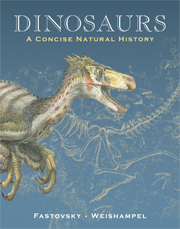Book contents
- Frontmatter
- Contents
- Why a natural history of dinosaurs?
- Dedication
- Part I Reaching back in time
- 1 To catch a dinosaur
- 2 Dinosaur days
- 3 Who's related to whom – and how do we know?
- 4 Who are the dinosaurs?
- Part II Ornithischia: armored, horned, and duck-billed dinosaurs
- Part III Saurischia: meat, might, and magnitude
- Part IV Endothermy, endemism, and extinction
- Glossary
- Figure credits
- Index of subjects
- Index of genera
1 - To catch a dinosaur
- Frontmatter
- Contents
- Why a natural history of dinosaurs?
- Dedication
- Part I Reaching back in time
- 1 To catch a dinosaur
- 2 Dinosaur days
- 3 Who's related to whom – and how do we know?
- 4 Who are the dinosaurs?
- Part II Ornithischia: armored, horned, and duck-billed dinosaurs
- Part III Saurischia: meat, might, and magnitude
- Part IV Endothermy, endemism, and extinction
- Glossary
- Figure credits
- Index of subjects
- Index of genera
Summary
Chapter objectives
Understanding fossils and fossilization
Collecting dinosaur fossils
Preparing dinosaur specimens
Tales of dinosaurs
This book is a tale of dinosaurs; who they were, what they did, and how they did it. But more significantly, it is also a tale of natural history. Dinosaurs enrich our concept of the biosphere, the three-dimensional layer of life that encircles the Earth. Our biosphere has a 3.8 billion-year history, and we and all the organisms around us are products of yet a fourth dimension: its history. To be unaware of the history of life is to be unaware of our organic connections to the rest of the world. Dinosaurs have significant lessons to impart in this regard, because, as we learn who dinosaurs really are, we can better understand who we really are.
Ours is also a tale of science itself. In an increasingly technical world, an understanding of science and how it affects lives is important. Science depends upon imagination and creativity, as well as data. In the following pages, we hope to build a sense of the intellectual richness of science, as well as a feel for what philosopher of science Karl Popper called the “logic of scientific discovery.”
The word “dinosaur” in this book. The term “dinosaur” (deinos – terrible; sauros – lizard) was invented in 1842 by the English naturalist Sir Richard Owen (see Box 14.2) to describe a few fossil bones of large, extinct reptiles.
- Type
- Chapter
- Information
- DinosaursA Concise Natural History, pp. 2 - 17Publisher: Cambridge University PressPrint publication year: 2009

